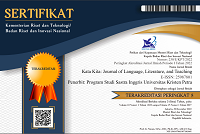Patriarchal bias against nature and women in “The Red Bekisar” by Ahmad Tohari: an ecofeminist reading
(1) Petra Christian University
(*) Corresponding Author
Abstract
Keywords
Full Text:
PDFReferences
Amoussou, F. & Allagbe, A. A. (2018). Principles, theories, and approaches to Critical Discourse Analysis. International Journal on Studies in English Language and Literature, 6(1), pp. 11-18. http://dx.doi.org/10.20431/2347-3134.0601002
Astuti, T. M. P. (2012). Ekofeminisme dan peran perempuan dalam lingkungan. Indonesian Journal of Conservation, 1(1), pp. 49-60. https://doi.org/10.15294/ijc.v1i1.2064
Bazregarzadeh, E. (2019). Susan Glaspell’s “Trifles” in the light of ecofeminism. K@ta, 21(1), 10-16. https://doi.org/10.9744/kata.21.1.10-16
Buckingham, S. (2004). Ecofeminism in the twenty-first century. The Geographical Journal, 170(2), 146–154. http://www.jstor.org/stable/3451591
Cuomo, C. (2002). On Ecofeminist Philosophy. Ethics and the Environment, 7(2), 1–11. http://www.jstor.org/stable/40339033
Dörnyei, Z. (2007). Research methods in applied linguistics: Quantitative, qualitative, and mixed methodologies. USA: Oxford University Press.
Glazebrook (2002). Karen Warren’s ecofeminism. Ethics and the Environment, Autumn, 2002, Vol. 7, No. 2 (Autumn, 2002), pp. 12-26.
Kemendikbud. (n.d.). Bekisar Merah (1993). In Ensiklopedia Sastra Indonesia. Retrieved December 18, 2023 from https://ensiklopedia.kemdikbud.go.id/sastra/artikel/Bekisar_Merah
Lalbakhsh, P., Khoshnood, A., & Gholami, F. (2015). Juxtaposition of women, culture, and nature in Alice Walker’s Possessing The Secret Of Joy. K@ta, 16(2), 93-100. https://doi.org/https://doi.org/10.9744/kata.16.2.93-100
Mokalu, P. V. V., Mogea, T., & Oroh, E. Z. (2023). Women’s resistance against hegemony in Nathaniel Hawthorne’s The Scarlet Letter and Ahmad Tohari’s Bekisar Merah: A comparative study. JELTEC: Journal of English Language Teaching, Literature and Culture, 2(1), pp. 6-83. https://doi.org/10.53682/jeltec.v2i1.6239
Setiari, I. (2022). Novel “Belantik” karya Ahmad Tohari (suatu kajian intertekstual). Jurnal Diksatrasia: Pendidikan Bahasa dan Sastra Indonesia, Vol. 6, No. 2 (Juli 2022), pp. 345-349. http://dx.doi.org/10.25157/diksatrasia.v6i2.9006
Statista. (2023, May 2). Most popular leisure activities in Indonesia 2022 [Graph]. https://www.statista.com/statistics/1344302/indonesia-most-popular-pastime/
Suharto, A. W. B. (2022). Al Quran and Hadits as ideas and sources of stories in Ahmad Tohari’s novels. IBDA: Jurnal Kajian Islam dan Budaya, 20(2), pp. 308-321. https://doi.org/10.24090/ibda.v20i2.6945
Suroso, Hartono, & Liliani, E. (2022). Nature representation in Ahmad Tohari’s works of fiction. European Journal of Language and Literature Studies, 8(2), pp. 1-14. https://revistia.org/index.php/ejls/article/view/5932
Tohari, A. (2011). The Red Bekisar. Jakarta: Dalang Publishing
Vijayaraj, B. (2017). A comprehensive study of ecofeminism. The Anthropologist, 30:1, 68-75, https://doi.org/10.1080/09720073.2017.1377862
Zimmerman, M. E., Callicott, J. B., Sessions, G., Warren, K. J., & Clark, J. (1998). Environmental philosophy: from animal rights to radical ecology (2nd ed.). New Jersey: Prentice-Hall
DOI: https://doi.org/10.9744/katakita.12.2.254-265
Refbacks
- There are currently no refbacks.
Supported by:
Indexed in:
Tools:
Stats (installed since 17 December 2018)
View My Stats













